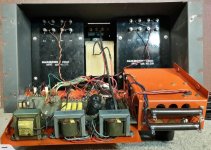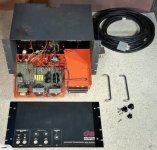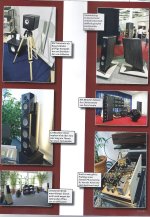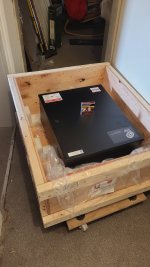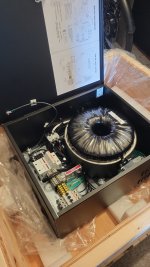The 780uF N.P. (cheap) cap helps at 50 Hz but not much below that. I think purpose is to protect our amps when amp has to input low notes to the transformers. (The inductor in the input circuit helps massage the transformer at the high end.) While these DW transformers may the greatest ever, still quite a task covering so much band. My empirically derived input circuit is a bit different than Mike's but based on his design.
I used to post freq profiles of recordings that has bass folks rave about. Usually strong bass at 80 Hz.
You are right to mention Fletcher-Munson or today's equivalents. So even if a mic hears bass flat to 30 Hz, humans wouldn't hear unless the test cranked up really loud. To even sense lowest pedals anywhere but a silent studio, no way to make curves on a vinyl record loud enough or for that matter, ESL speakers.
Good stuff at Bay-Bloor Radio.... been visiting since 1969. But just a few blocks away is St Pauls on Bloor with a wonderful Aeolian-Skinner 5-manual organ and lotsa stone to vibrate and other major church organs in town. Have you seen my repeated posts of the annual Halloween event at Metropolitan United when the noisiest organ music available and played dramatically delights the costumed audience?
Ben
I used to post freq profiles of recordings that has bass folks rave about. Usually strong bass at 80 Hz.
You are right to mention Fletcher-Munson or today's equivalents. So even if a mic hears bass flat to 30 Hz, humans wouldn't hear unless the test cranked up really loud. To even sense lowest pedals anywhere but a silent studio, no way to make curves on a vinyl record loud enough or for that matter, ESL speakers.
Good stuff at Bay-Bloor Radio.... been visiting since 1969. But just a few blocks away is St Pauls on Bloor with a wonderful Aeolian-Skinner 5-manual organ and lotsa stone to vibrate and other major church organs in town. Have you seen my repeated posts of the annual Halloween event at Metropolitan United when the noisiest organ music available and played dramatically delights the costumed audience?
Ben
Hi Dan,One side crackled and the other was dead.
having spent countless hours with several XG8 :
this is most likely the typical leakage in the high voltage plugs !
I have several pairs and these plugs all do leak sooner or later, then sound is dead/lower at that side - the other may work perfectly. I regard the old resin in the plugs to detoriate. The sockets at the speaker luckily do not have this problem...
The high voltage PSU in the ST300 box has such a high output impedance, even small leakage makes the polarizing voltage drop to nothing.
Solution : cut the cable just before the plug, look at the plug/connections in the manual link. Then be creative.
I ended up with a flexible High voltage adapter cable ( thick insulation ) about 20cm long with simple banana sockets at one side. Critical are three wires : one for polarizing voltage and two for the music voltage.
At the speaker socket solder with care these three wires to the metal pins, then I took corona dope and made a wide, thick "envelope" surrounding the cabel/pin contact and let it dry, put another layer of this sticky dope until the envelope is really water proof. Before using the dope think of a solid mechanical fixation of the 20cm adapter cable, e.g. by pressing all the wires to a little wooden bar mounted nearby the socket.
The banana plugs I simply covered generously with thick plastic tube after connecting to the cable from the ST300...the other cables to the plug are not critical regarding HV insulation, e.g. use normal 230V flexible wires..
Do yourself a favour and at least replace the relay on the crossover board...
I hope this helps, Philipp
If Jan Didden is reading this thread, feel free to send me a message, and congrats to your high voltage amplifier !
I have a similar big project for this in the pipeline for years now, the serious requirements for a direct amp after all my experiments :
5kVeff peak output voltage and and 200mA peak output current ( midrange / treble ) combined with low bias current, audio bandwidth, low distortion !
I hope to find the time following this project soon...
All this only for skilled guys, who know to take care !
Below 500Hz XG8 is very easy to drive, only voltage needed, I plan to use a bridged Sony TA FA777ES, one for each side ! When slightly refurbished/tweaked this is a very nice amplifier by the whay ...
This is the ST300A, a little newer model than the ST300 I guess
Have fun, Philipp
I have a similar big project for this in the pipeline for years now, the serious requirements for a direct amp after all my experiments :
5kVeff peak output voltage and and 200mA peak output current ( midrange / treble ) combined with low bias current, audio bandwidth, low distortion !
I hope to find the time following this project soon...
All this only for skilled guys, who know to take care !
Below 500Hz XG8 is very easy to drive, only voltage needed, I plan to use a bridged Sony TA FA777ES, one for each side ! When slightly refurbished/tweaked this is a very nice amplifier by the whay ...
This is the ST300A, a little newer model than the ST300 I guess
Have fun, Philipp
Attachments
I built a HV amp (like Sanders but better design) and drove a pair of unmodified XG? for some decades. Klipschorn bass below 130 Hz and Dennison ESL tweeters above 4kHz.
No question it was the best sound I ever produced.
Anybody who can make a HV amp (and does not have little children around) should definitely do it.
No question it was the best sound I ever produced.
Anybody who can make a HV amp (and does not have little children around) should definitely do it.
If you use this formIf Jan Didden is reading this thread
@jan.didden
the forum will send an alert to the user that they were mentioned.
... which I received. Agree on the skilled requirement - this is no kids play, literally.
@invisible force, I understand you are rebuilding a DW direct drive amp?
I chickened out for the 200mAeff for driving the higher frequencies and concentrated on the QUAD ESL 63 family.
Due to the transmission line drive for the concemtric panels, the impedance is mostly resistive (300k-400k) which is much easier to drive.
For the newer version on which I am working I use a class A design with 25mA bias, with 4kV total supply and inductive load on the output tubes (GI-17), hopefully to get close to 8kV pk-pk.
Your 5kV at 200mA must be a monster!
Jan
@invisible force, I understand you are rebuilding a DW direct drive amp?
I chickened out for the 200mAeff for driving the higher frequencies and concentrated on the QUAD ESL 63 family.
Due to the transmission line drive for the concemtric panels, the impedance is mostly resistive (300k-400k) which is much easier to drive.
For the newer version on which I am working I use a class A design with 25mA bias, with 4kV total supply and inductive load on the output tubes (GI-17), hopefully to get close to 8kV pk-pk.
Your 5kV at 200mA must be a monster!
Jan
Sulfur Hexafloride (SF6)is an extremely dense gas (.4 pounds per cubic foot @stp). When added into a sealed speaker enclosure, it has a volumetric expansion effect...incidentally, when inhaled, gives the opposite effect of inhaling Helium, so you can sound like Barry White (not exactly inert - do not try this).
I always wanted to try adding Carbon Dioxide (.124 pounds per cubic foot @stp) into a sealed subwoofer or speaker to see if it also has the same volumetric expansion effect...SF6 and CO2 literally "pours" like water.
BTW - Perfluorobutane is inert and has almost twice the density of sulfur hexafluoride...
Also, (hey, what the hell) we had these nasty Voles in our lawn that burrowed under ground and ate the roots of grass, leaving dead grass "veins" all across our lawn...I simply dropped a couple dry ice pucks down into the holes...the dry Ice sublimes into the heavy CO2 gas, filling the entire tunnel, and put those little bastards to sleep, permanently...why can't the city of Chicago do the same to kill rats in the sewer system?
I always wanted to try adding Carbon Dioxide (.124 pounds per cubic foot @stp) into a sealed subwoofer or speaker to see if it also has the same volumetric expansion effect...SF6 and CO2 literally "pours" like water.
BTW - Perfluorobutane is inert and has almost twice the density of sulfur hexafluoride...
Also, (hey, what the hell) we had these nasty Voles in our lawn that burrowed under ground and ate the roots of grass, leaving dead grass "veins" all across our lawn...I simply dropped a couple dry ice pucks down into the holes...the dry Ice sublimes into the heavy CO2 gas, filling the entire tunnel, and put those little bastards to sleep, permanently...why can't the city of Chicago do the same to kill rats in the sewer system?
Last edited:
wow, Jan this is fast response !
no rebuild of any circuit kown to me... circuit is based on my single stage moving coil to aux level phono preamp, photo attached (right corner - high end 2011, respectable man Thomas Fast played it ).. well, all voltages a bit higher 😎
the existing circuit is not ready on the 5kV/200mA scale on my table now, but I know it will be and working serial wide bandwidth power MOSFET connection is officially protected..by me
I do appreciate your linear audio magazine project a lot, I have almost every issue...
I need a knowing, trustworthy gentleman ( beside Andreas Schubert in Berlin and Joachim Gerhard, but both not so much in touch with ESL ), woh`s lips are sealed, to share my thoughts...
I spent my last years to become a man like Dagobert Duck, I am a convinced pauperist 😎
< Ausgaben, Unkosten,Hungertuch, Ruin ! > advantage is : some gold for this project is save 🙂
send me a message, I will return my telephone number, just opened a second bottle of Sancerre whine : electrostatic loudspeaker fans, I salute you !
have fun, Philipp
no rebuild of any circuit kown to me... circuit is based on my single stage moving coil to aux level phono preamp, photo attached (right corner - high end 2011, respectable man Thomas Fast played it ).. well, all voltages a bit higher 😎
the existing circuit is not ready on the 5kV/200mA scale on my table now, but I know it will be and working serial wide bandwidth power MOSFET connection is officially protected..by me
I do appreciate your linear audio magazine project a lot, I have almost every issue...
I need a knowing, trustworthy gentleman ( beside Andreas Schubert in Berlin and Joachim Gerhard, but both not so much in touch with ESL ), woh`s lips are sealed, to share my thoughts...
I spent my last years to become a man like Dagobert Duck, I am a convinced pauperist 😎
< Ausgaben, Unkosten,Hungertuch, Ruin ! > advantage is : some gold for this project is save 🙂
send me a message, I will return my telephone number, just opened a second bottle of Sancerre whine : electrostatic loudspeaker fans, I salute you !
have fun, Philipp
Attachments
Jan ,
traditional class A is practical for ESL headphones, and I do like the Stax 009 heaphone, it is my reference transducer, the headphone itself, not the direct amps offered by Stax ...threre is a good reason for the aftermarket for the stax headphone amps..
1mA bias with 1KV supply is 1W heat ..this is an inacceptable heater with the needed +- 5kV supply and 200mA bias..even if bridged, so a no switching output stage is mandatory..low bias, high bandwidth and always keeping in mind :
is the effort really worthwhile compared to a good transformer ?
The DW transformer made by Hammond is a piece of art : little whobble around 10Khz, but up to 20Khz and above flat !
price to pay : internal capacitance of the transformer will suck out any normal amplifier´s current capabilities above ~2kHz ...difference of the speaker connected connected to the step up transformer compared to the transformer alone is low - seen from the amp..long stories, I close for now,
have fun,
Philipp
traditional class A is practical for ESL headphones, and I do like the Stax 009 heaphone, it is my reference transducer, the headphone itself, not the direct amps offered by Stax ...threre is a good reason for the aftermarket for the stax headphone amps..
1mA bias with 1KV supply is 1W heat ..this is an inacceptable heater with the needed +- 5kV supply and 200mA bias..even if bridged, so a no switching output stage is mandatory..low bias, high bandwidth and always keeping in mind :
is the effort really worthwhile compared to a good transformer ?
The DW transformer made by Hammond is a piece of art : little whobble around 10Khz, but up to 20Khz and above flat !
price to pay : internal capacitance of the transformer will suck out any normal amplifier´s current capabilities above ~2kHz ...difference of the speaker connected connected to the step up transformer compared to the transformer alone is low - seen from the amp..long stories, I close for now,
have fun,
Philipp
For the ES63, the difference in distortion between my direct drive amp and the step up is almost 40dB - a factor 100.
Do you hear that?
The folks at the ETF in 2022 said they did, and that the direct drive gave more resolution and detail.
Menno Vanderveen, our long-time transformer designer (he also designed a couple of step ups) thought he could hear the transformer contribition being absent in the dd case.
For whatever it is worth.
Jan
Do you hear that?
The folks at the ETF in 2022 said they did, and that the direct drive gave more resolution and detail.
Menno Vanderveen, our long-time transformer designer (he also designed a couple of step ups) thought he could hear the transformer contribition being absent in the dd case.
For whatever it is worth.
Jan
Dear Jan,For whatever it is worth.
👍👍
your HV amplifier article is on the Linear Audio site ?
I will look for my login on my old Labtop...
Have you ever used your amp for driving a STAX headphone ?
regards, Philipp
small world...he also contributed to the great Torus Power Filter Transformers..Menno Vanderveen
😎
Attachments
I think Nelson Pass once wrote, that he successfully included the DW step up transformer in a feedback loop to lower distortion even more..maybe Nelson is following here in the background ?
regards, Philipp
regards, Philipp
Menno Vanderveen
Aw. I remember having coffee with him and Bill Perkins (who, at least at the time [AES 1999 NYNY], Menno’s equal in terms of transformers). They went back and forth with deep theoretical transformer stuff. Absolutrly fascinating, and way over my head.
dave
I think Nelson Pass once wrote, that he successfully included the DW step up transformer in a feedback loop to lower distortion even more..maybe Nelson is following here in the background ?
regards, Philipp
@Nelson Pass?
dave
maudio´s comments on direct drive of ESL speakers :
https://www.diyaudio.com/community/threads/another-direct-drive-thread.80714/#post-930459
regards, Philipp
https://www.diyaudio.com/community/threads/another-direct-drive-thread.80714/#post-930459
regards, Philipp
Here Nelson Pass is interviewed on his ion cloud speaker attempt...
starting ~11:00 he talks about Dayton Wright..
regards, Philipp
starting ~11:00 he talks about Dayton Wright..
With all do respect. Having 2kV AC component at few kilocycles.
Is it OK to use DCDC converter specified for 250VAC working voltage?
- Home
- Loudspeakers
- Planars & Exotics
- Dayton-Wright ESL
